BBMM506 Strategic Management: Porter's Five Forces Analysis - Aldi
VerifiedAdded on 2023/06/15
|10
|2188
|351
Report
AI Summary
This report provides a strategic analysis of Aldi Australia using Porter's Five Forces model to assess the competitive intensity and attractiveness of the supermarket industry. It examines the threats of new entrants and substitute products, the bargaining power of suppliers and buyers, and the competitive rivalry within the market. The analysis reveals that Aldi faces medium threat of new entrants, high threat of substitute products, low bargaining power of suppliers, high bargaining power of purchasers, and high competitive rivalry. Key findings highlight the need for product diversification, competitor capability assessment, a shift towards marketing and promotional activities, infrastructure improvement, and the implementation of competitive pricing strategies. Recommendations are provided to enhance Aldi's competitive advantage and influence consumer buying behavior. The report concludes that strategic management is crucial for Aldi to generate better revenue and gain a competitive edge in the Australian market.
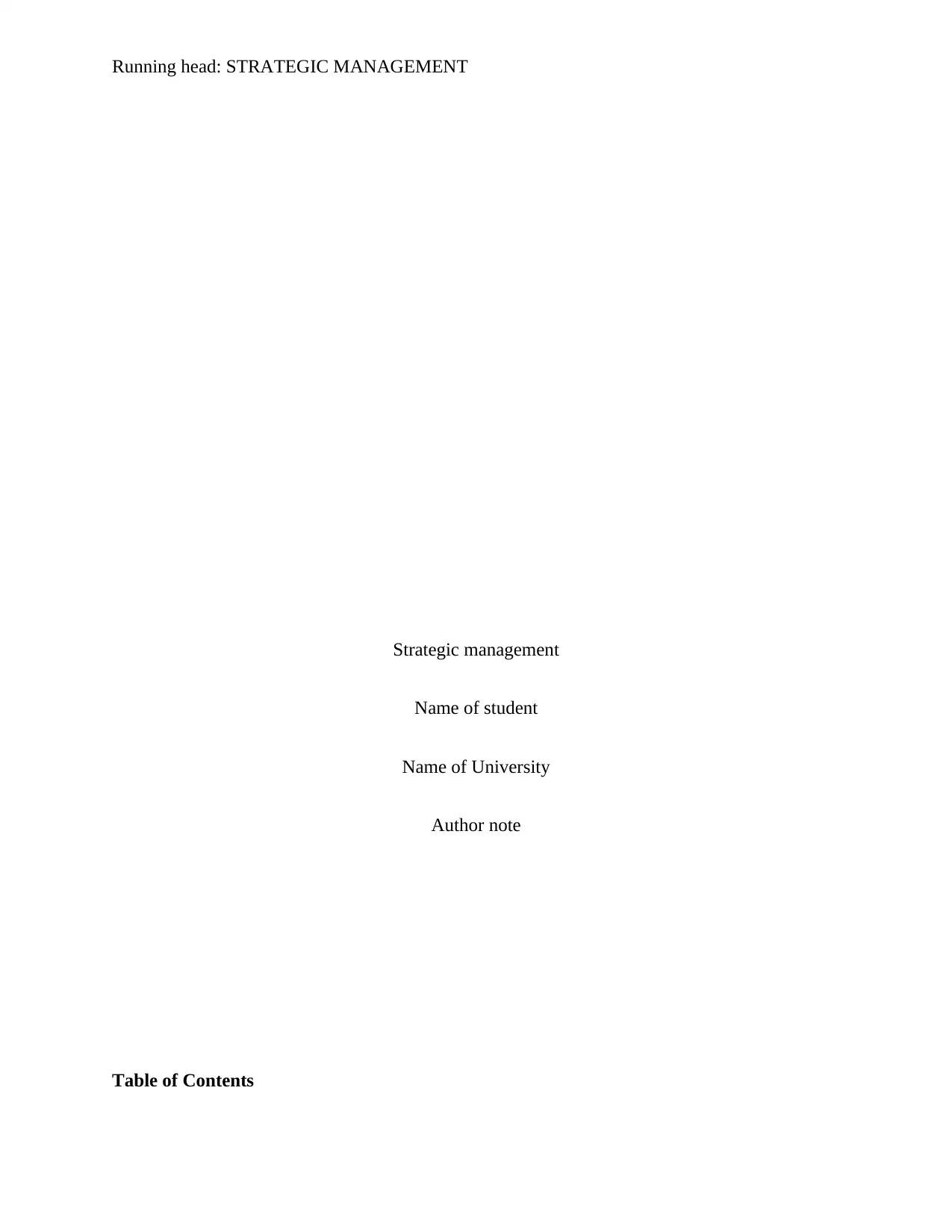
Running head: STRATEGIC MANAGEMENT
Strategic management
Name of student
Name of University
Author note
Table of Contents
Strategic management
Name of student
Name of University
Author note
Table of Contents
Paraphrase This Document
Need a fresh take? Get an instant paraphrase of this document with our AI Paraphraser
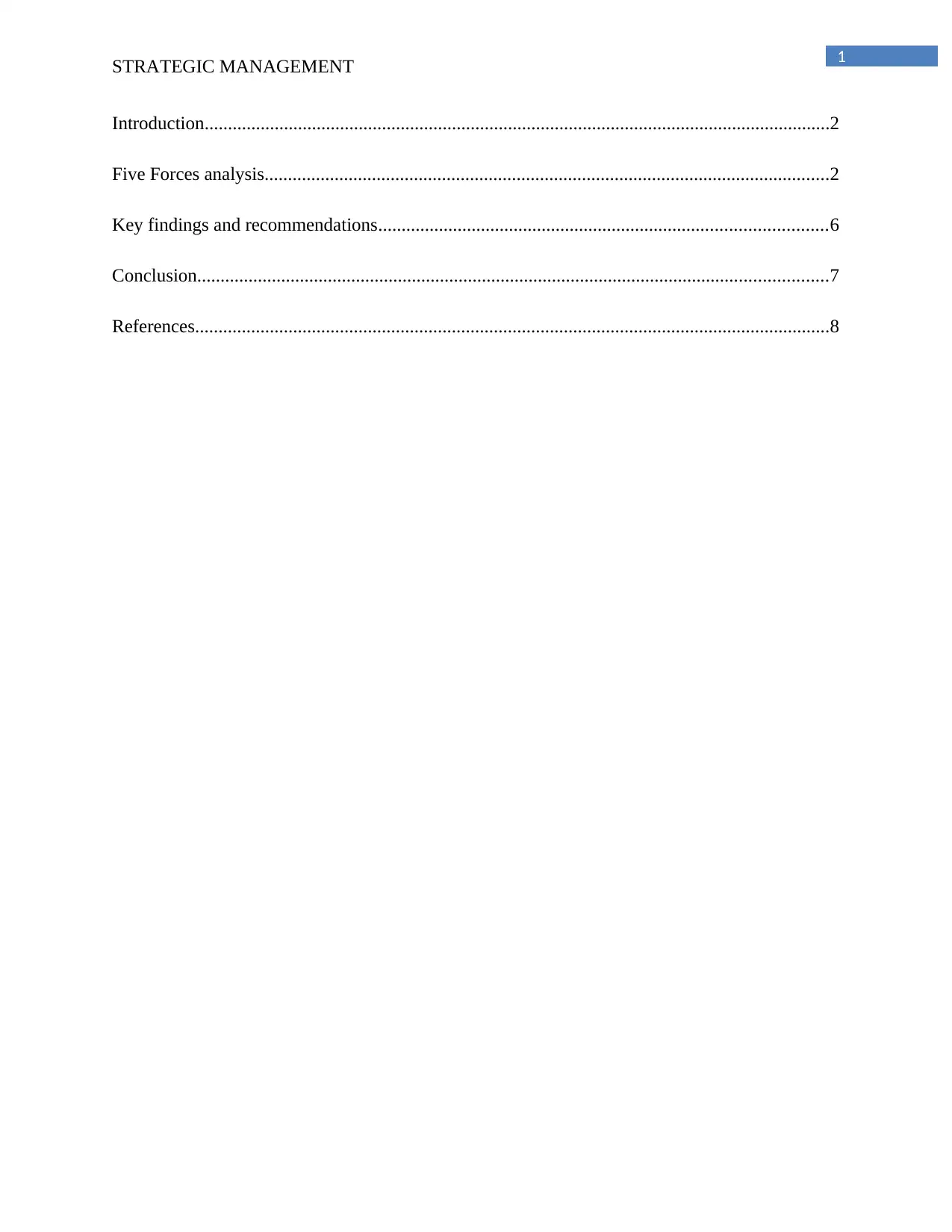
1
STRATEGIC MANAGEMENT
Introduction......................................................................................................................................2
Five Forces analysis.........................................................................................................................2
Key findings and recommendations................................................................................................6
Conclusion.......................................................................................................................................7
References........................................................................................................................................8
STRATEGIC MANAGEMENT
Introduction......................................................................................................................................2
Five Forces analysis.........................................................................................................................2
Key findings and recommendations................................................................................................6
Conclusion.......................................................................................................................................7
References........................................................................................................................................8
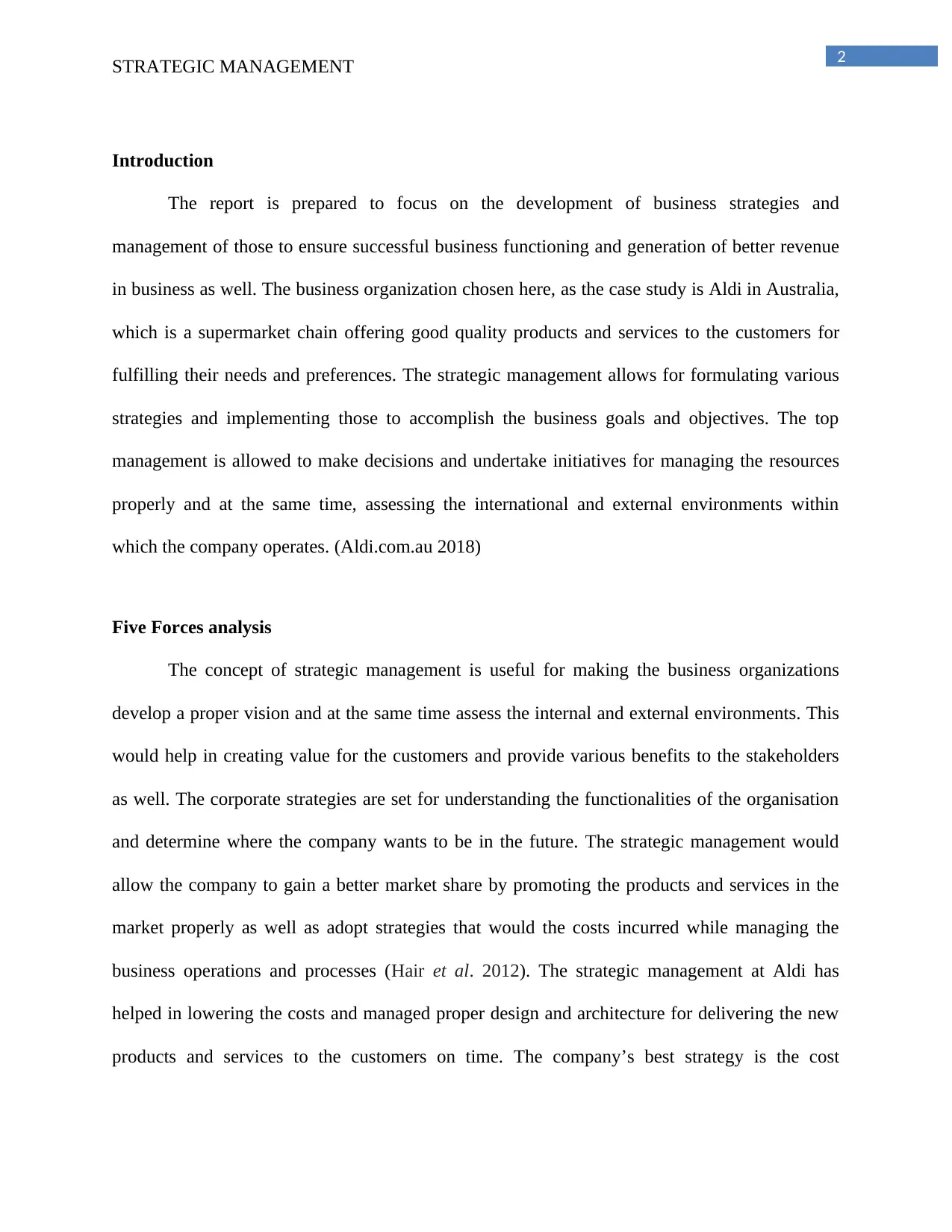
2
STRATEGIC MANAGEMENT
Introduction
The report is prepared to focus on the development of business strategies and
management of those to ensure successful business functioning and generation of better revenue
in business as well. The business organization chosen here, as the case study is Aldi in Australia,
which is a supermarket chain offering good quality products and services to the customers for
fulfilling their needs and preferences. The strategic management allows for formulating various
strategies and implementing those to accomplish the business goals and objectives. The top
management is allowed to make decisions and undertake initiatives for managing the resources
properly and at the same time, assessing the international and external environments within
which the company operates. (Aldi.com.au 2018)
Five Forces analysis
The concept of strategic management is useful for making the business organizations
develop a proper vision and at the same time assess the internal and external environments. This
would help in creating value for the customers and provide various benefits to the stakeholders
as well. The corporate strategies are set for understanding the functionalities of the organisation
and determine where the company wants to be in the future. The strategic management would
allow the company to gain a better market share by promoting the products and services in the
market properly as well as adopt strategies that would the costs incurred while managing the
business operations and processes (Hair et al. 2012). The strategic management at Aldi has
helped in lowering the costs and managed proper design and architecture for delivering the new
products and services to the customers on time. The company’s best strategy is the cost
STRATEGIC MANAGEMENT
Introduction
The report is prepared to focus on the development of business strategies and
management of those to ensure successful business functioning and generation of better revenue
in business as well. The business organization chosen here, as the case study is Aldi in Australia,
which is a supermarket chain offering good quality products and services to the customers for
fulfilling their needs and preferences. The strategic management allows for formulating various
strategies and implementing those to accomplish the business goals and objectives. The top
management is allowed to make decisions and undertake initiatives for managing the resources
properly and at the same time, assessing the international and external environments within
which the company operates. (Aldi.com.au 2018)
Five Forces analysis
The concept of strategic management is useful for making the business organizations
develop a proper vision and at the same time assess the internal and external environments. This
would help in creating value for the customers and provide various benefits to the stakeholders
as well. The corporate strategies are set for understanding the functionalities of the organisation
and determine where the company wants to be in the future. The strategic management would
allow the company to gain a better market share by promoting the products and services in the
market properly as well as adopt strategies that would the costs incurred while managing the
business operations and processes (Hair et al. 2012). The strategic management at Aldi has
helped in lowering the costs and managed proper design and architecture for delivering the new
products and services to the customers on time. The company’s best strategy is the cost
⊘ This is a preview!⊘
Do you want full access?
Subscribe today to unlock all pages.

Trusted by 1+ million students worldwide
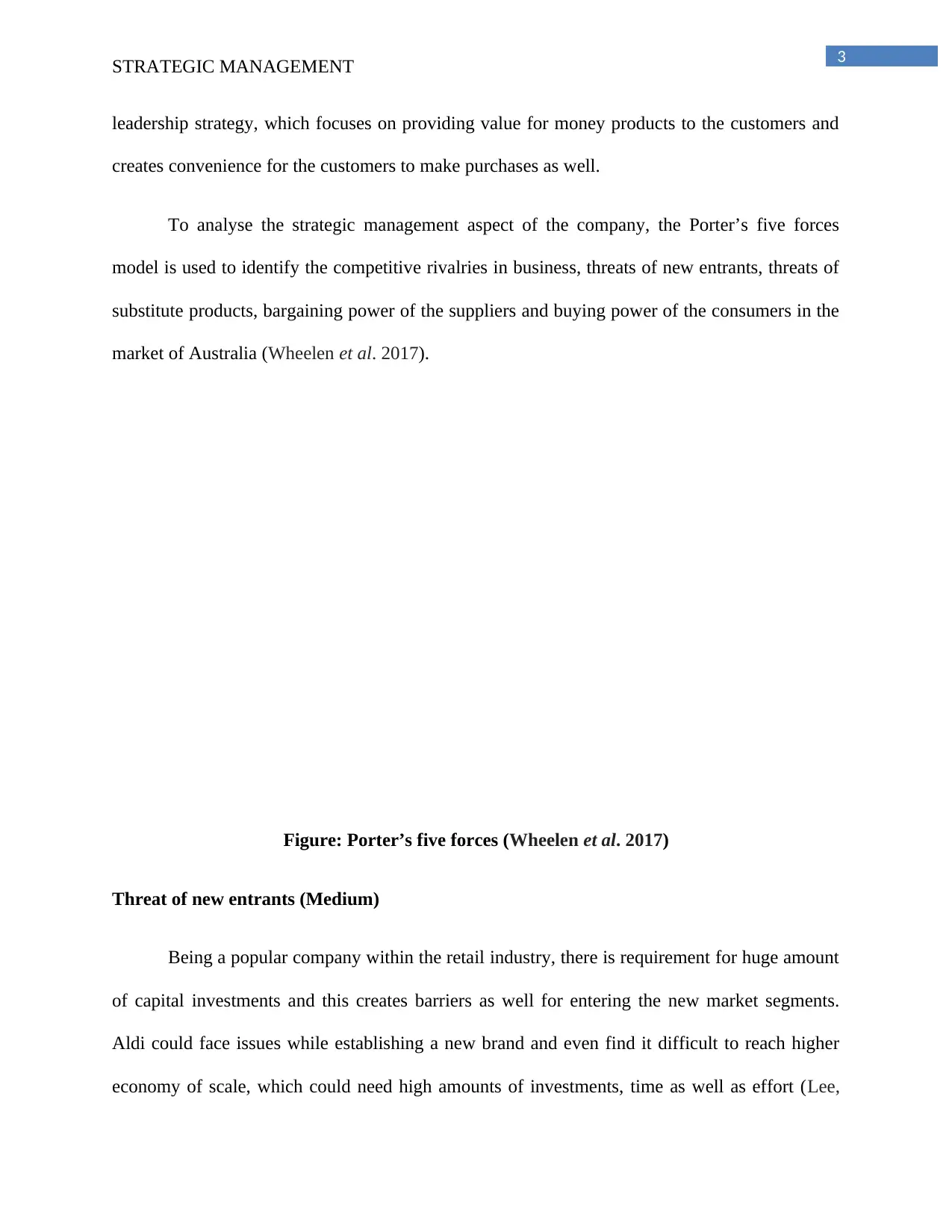
3
STRATEGIC MANAGEMENT
leadership strategy, which focuses on providing value for money products to the customers and
creates convenience for the customers to make purchases as well.
To analyse the strategic management aspect of the company, the Porter’s five forces
model is used to identify the competitive rivalries in business, threats of new entrants, threats of
substitute products, bargaining power of the suppliers and buying power of the consumers in the
market of Australia (Wheelen et al. 2017).
Figure: Porter’s five forces (Wheelen et al. 2017)
Threat of new entrants (Medium)
Being a popular company within the retail industry, there is requirement for huge amount
of capital investments and this creates barriers as well for entering the new market segments.
Aldi could face issues while establishing a new brand and even find it difficult to reach higher
economy of scale, which could need high amounts of investments, time as well as effort (Lee,
STRATEGIC MANAGEMENT
leadership strategy, which focuses on providing value for money products to the customers and
creates convenience for the customers to make purchases as well.
To analyse the strategic management aspect of the company, the Porter’s five forces
model is used to identify the competitive rivalries in business, threats of new entrants, threats of
substitute products, bargaining power of the suppliers and buying power of the consumers in the
market of Australia (Wheelen et al. 2017).
Figure: Porter’s five forces (Wheelen et al. 2017)
Threat of new entrants (Medium)
Being a popular company within the retail industry, there is requirement for huge amount
of capital investments and this creates barriers as well for entering the new market segments.
Aldi could face issues while establishing a new brand and even find it difficult to reach higher
economy of scale, which could need high amounts of investments, time as well as effort (Lee,
Paraphrase This Document
Need a fresh take? Get an instant paraphrase of this document with our AI Paraphraser
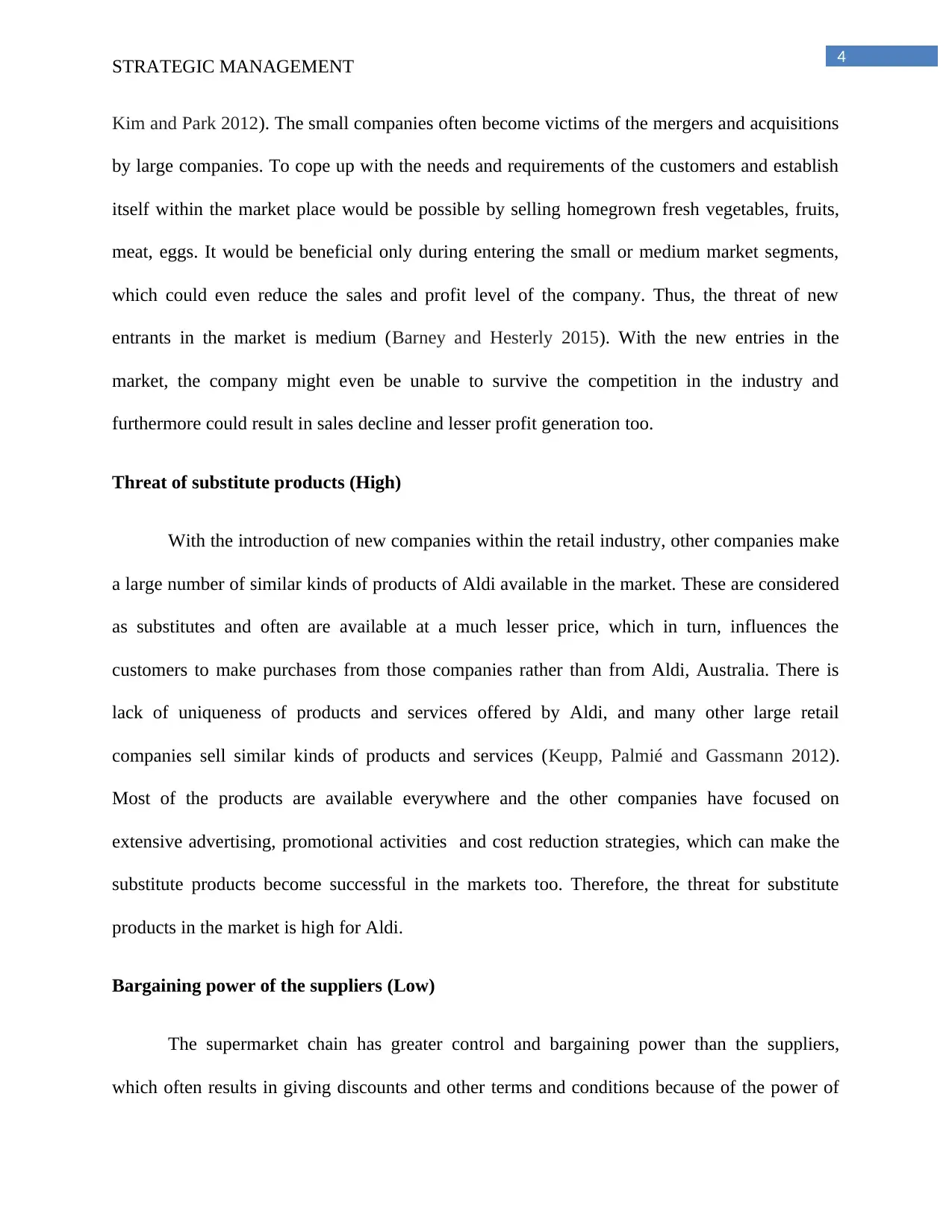
4
STRATEGIC MANAGEMENT
Kim and Park 2012). The small companies often become victims of the mergers and acquisitions
by large companies. To cope up with the needs and requirements of the customers and establish
itself within the market place would be possible by selling homegrown fresh vegetables, fruits,
meat, eggs. It would be beneficial only during entering the small or medium market segments,
which could even reduce the sales and profit level of the company. Thus, the threat of new
entrants in the market is medium (Barney and Hesterly 2015). With the new entries in the
market, the company might even be unable to survive the competition in the industry and
furthermore could result in sales decline and lesser profit generation too.
Threat of substitute products (High)
With the introduction of new companies within the retail industry, other companies make
a large number of similar kinds of products of Aldi available in the market. These are considered
as substitutes and often are available at a much lesser price, which in turn, influences the
customers to make purchases from those companies rather than from Aldi, Australia. There is
lack of uniqueness of products and services offered by Aldi, and many other large retail
companies sell similar kinds of products and services (Keupp, Palmié and Gassmann 2012).
Most of the products are available everywhere and the other companies have focused on
extensive advertising, promotional activities and cost reduction strategies, which can make the
substitute products become successful in the markets too. Therefore, the threat for substitute
products in the market is high for Aldi.
Bargaining power of the suppliers (Low)
The supermarket chain has greater control and bargaining power than the suppliers,
which often results in giving discounts and other terms and conditions because of the power of
STRATEGIC MANAGEMENT
Kim and Park 2012). The small companies often become victims of the mergers and acquisitions
by large companies. To cope up with the needs and requirements of the customers and establish
itself within the market place would be possible by selling homegrown fresh vegetables, fruits,
meat, eggs. It would be beneficial only during entering the small or medium market segments,
which could even reduce the sales and profit level of the company. Thus, the threat of new
entrants in the market is medium (Barney and Hesterly 2015). With the new entries in the
market, the company might even be unable to survive the competition in the industry and
furthermore could result in sales decline and lesser profit generation too.
Threat of substitute products (High)
With the introduction of new companies within the retail industry, other companies make
a large number of similar kinds of products of Aldi available in the market. These are considered
as substitutes and often are available at a much lesser price, which in turn, influences the
customers to make purchases from those companies rather than from Aldi, Australia. There is
lack of uniqueness of products and services offered by Aldi, and many other large retail
companies sell similar kinds of products and services (Keupp, Palmié and Gassmann 2012).
Most of the products are available everywhere and the other companies have focused on
extensive advertising, promotional activities and cost reduction strategies, which can make the
substitute products become successful in the markets too. Therefore, the threat for substitute
products in the market is high for Aldi.
Bargaining power of the suppliers (Low)
The supermarket chain has greater control and bargaining power than the suppliers,
which often results in giving discounts and other terms and conditions because of the power of
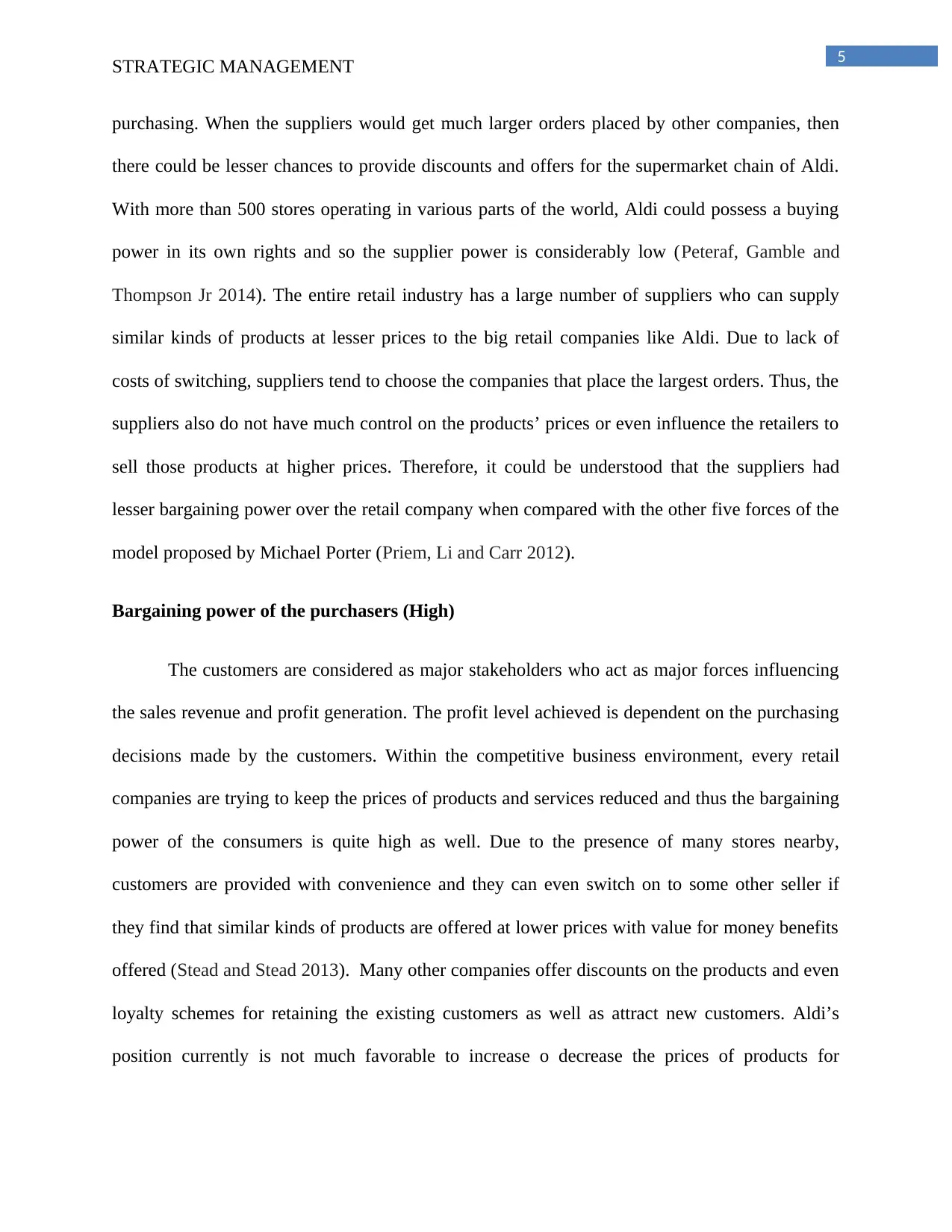
5
STRATEGIC MANAGEMENT
purchasing. When the suppliers would get much larger orders placed by other companies, then
there could be lesser chances to provide discounts and offers for the supermarket chain of Aldi.
With more than 500 stores operating in various parts of the world, Aldi could possess a buying
power in its own rights and so the supplier power is considerably low (Peteraf, Gamble and
Thompson Jr 2014). The entire retail industry has a large number of suppliers who can supply
similar kinds of products at lesser prices to the big retail companies like Aldi. Due to lack of
costs of switching, suppliers tend to choose the companies that place the largest orders. Thus, the
suppliers also do not have much control on the products’ prices or even influence the retailers to
sell those products at higher prices. Therefore, it could be understood that the suppliers had
lesser bargaining power over the retail company when compared with the other five forces of the
model proposed by Michael Porter (Priem, Li and Carr 2012).
Bargaining power of the purchasers (High)
The customers are considered as major stakeholders who act as major forces influencing
the sales revenue and profit generation. The profit level achieved is dependent on the purchasing
decisions made by the customers. Within the competitive business environment, every retail
companies are trying to keep the prices of products and services reduced and thus the bargaining
power of the consumers is quite high as well. Due to the presence of many stores nearby,
customers are provided with convenience and they can even switch on to some other seller if
they find that similar kinds of products are offered at lower prices with value for money benefits
offered (Stead and Stead 2013). Many other companies offer discounts on the products and even
loyalty schemes for retaining the existing customers as well as attract new customers. Aldi’s
position currently is not much favorable to increase o decrease the prices of products for
STRATEGIC MANAGEMENT
purchasing. When the suppliers would get much larger orders placed by other companies, then
there could be lesser chances to provide discounts and offers for the supermarket chain of Aldi.
With more than 500 stores operating in various parts of the world, Aldi could possess a buying
power in its own rights and so the supplier power is considerably low (Peteraf, Gamble and
Thompson Jr 2014). The entire retail industry has a large number of suppliers who can supply
similar kinds of products at lesser prices to the big retail companies like Aldi. Due to lack of
costs of switching, suppliers tend to choose the companies that place the largest orders. Thus, the
suppliers also do not have much control on the products’ prices or even influence the retailers to
sell those products at higher prices. Therefore, it could be understood that the suppliers had
lesser bargaining power over the retail company when compared with the other five forces of the
model proposed by Michael Porter (Priem, Li and Carr 2012).
Bargaining power of the purchasers (High)
The customers are considered as major stakeholders who act as major forces influencing
the sales revenue and profit generation. The profit level achieved is dependent on the purchasing
decisions made by the customers. Within the competitive business environment, every retail
companies are trying to keep the prices of products and services reduced and thus the bargaining
power of the consumers is quite high as well. Due to the presence of many stores nearby,
customers are provided with convenience and they can even switch on to some other seller if
they find that similar kinds of products are offered at lower prices with value for money benefits
offered (Stead and Stead 2013). Many other companies offer discounts on the products and even
loyalty schemes for retaining the existing customers as well as attract new customers. Aldi’s
position currently is not much favorable to increase o decrease the prices of products for
⊘ This is a preview!⊘
Do you want full access?
Subscribe today to unlock all pages.

Trusted by 1+ million students worldwide
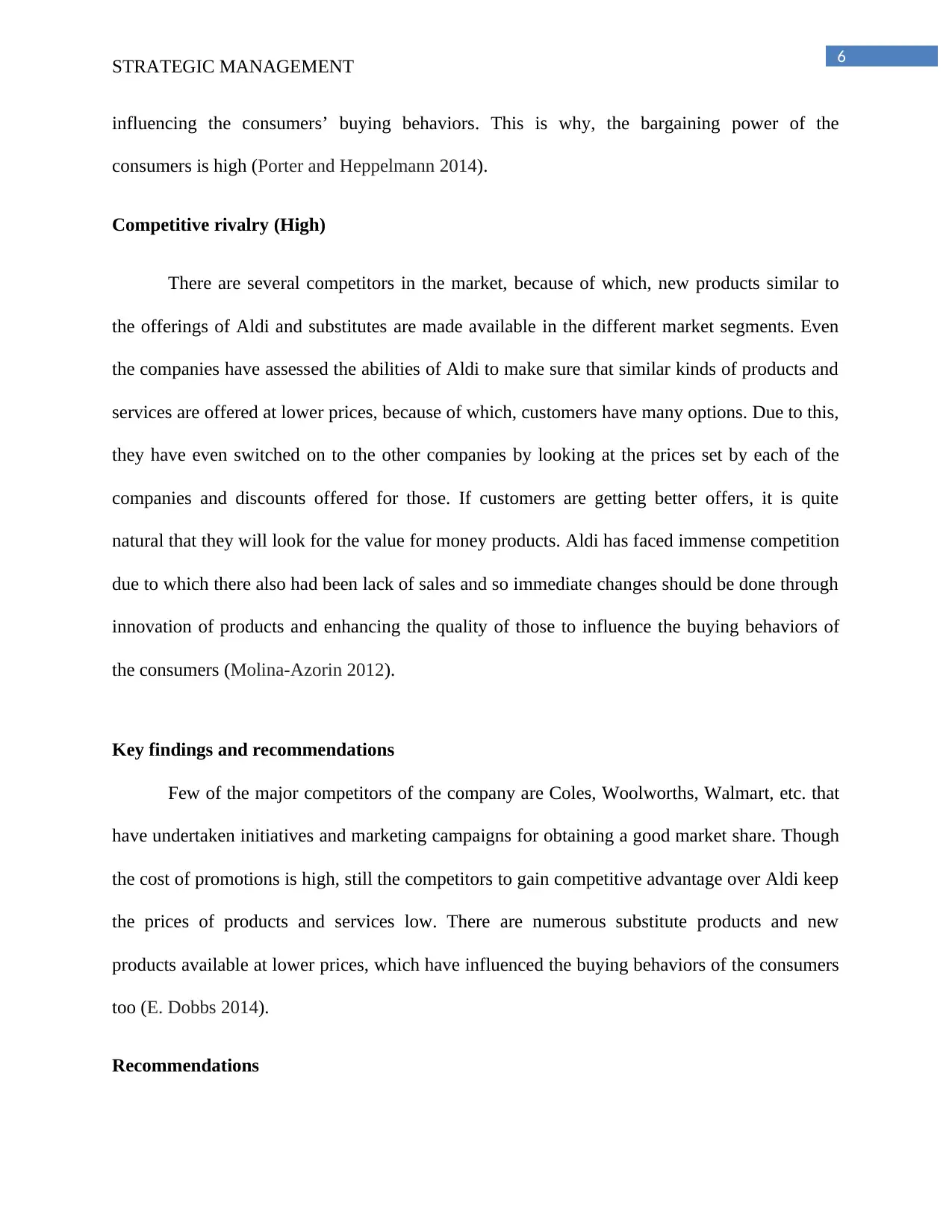
6
STRATEGIC MANAGEMENT
influencing the consumers’ buying behaviors. This is why, the bargaining power of the
consumers is high (Porter and Heppelmann 2014).
Competitive rivalry (High)
There are several competitors in the market, because of which, new products similar to
the offerings of Aldi and substitutes are made available in the different market segments. Even
the companies have assessed the abilities of Aldi to make sure that similar kinds of products and
services are offered at lower prices, because of which, customers have many options. Due to this,
they have even switched on to the other companies by looking at the prices set by each of the
companies and discounts offered for those. If customers are getting better offers, it is quite
natural that they will look for the value for money products. Aldi has faced immense competition
due to which there also had been lack of sales and so immediate changes should be done through
innovation of products and enhancing the quality of those to influence the buying behaviors of
the consumers (Molina-Azorin 2012).
Key findings and recommendations
Few of the major competitors of the company are Coles, Woolworths, Walmart, etc. that
have undertaken initiatives and marketing campaigns for obtaining a good market share. Though
the cost of promotions is high, still the competitors to gain competitive advantage over Aldi keep
the prices of products and services low. There are numerous substitute products and new
products available at lower prices, which have influenced the buying behaviors of the consumers
too (E. Dobbs 2014).
Recommendations
STRATEGIC MANAGEMENT
influencing the consumers’ buying behaviors. This is why, the bargaining power of the
consumers is high (Porter and Heppelmann 2014).
Competitive rivalry (High)
There are several competitors in the market, because of which, new products similar to
the offerings of Aldi and substitutes are made available in the different market segments. Even
the companies have assessed the abilities of Aldi to make sure that similar kinds of products and
services are offered at lower prices, because of which, customers have many options. Due to this,
they have even switched on to the other companies by looking at the prices set by each of the
companies and discounts offered for those. If customers are getting better offers, it is quite
natural that they will look for the value for money products. Aldi has faced immense competition
due to which there also had been lack of sales and so immediate changes should be done through
innovation of products and enhancing the quality of those to influence the buying behaviors of
the consumers (Molina-Azorin 2012).
Key findings and recommendations
Few of the major competitors of the company are Coles, Woolworths, Walmart, etc. that
have undertaken initiatives and marketing campaigns for obtaining a good market share. Though
the cost of promotions is high, still the competitors to gain competitive advantage over Aldi keep
the prices of products and services low. There are numerous substitute products and new
products available at lower prices, which have influenced the buying behaviors of the consumers
too (E. Dobbs 2014).
Recommendations
Paraphrase This Document
Need a fresh take? Get an instant paraphrase of this document with our AI Paraphraser
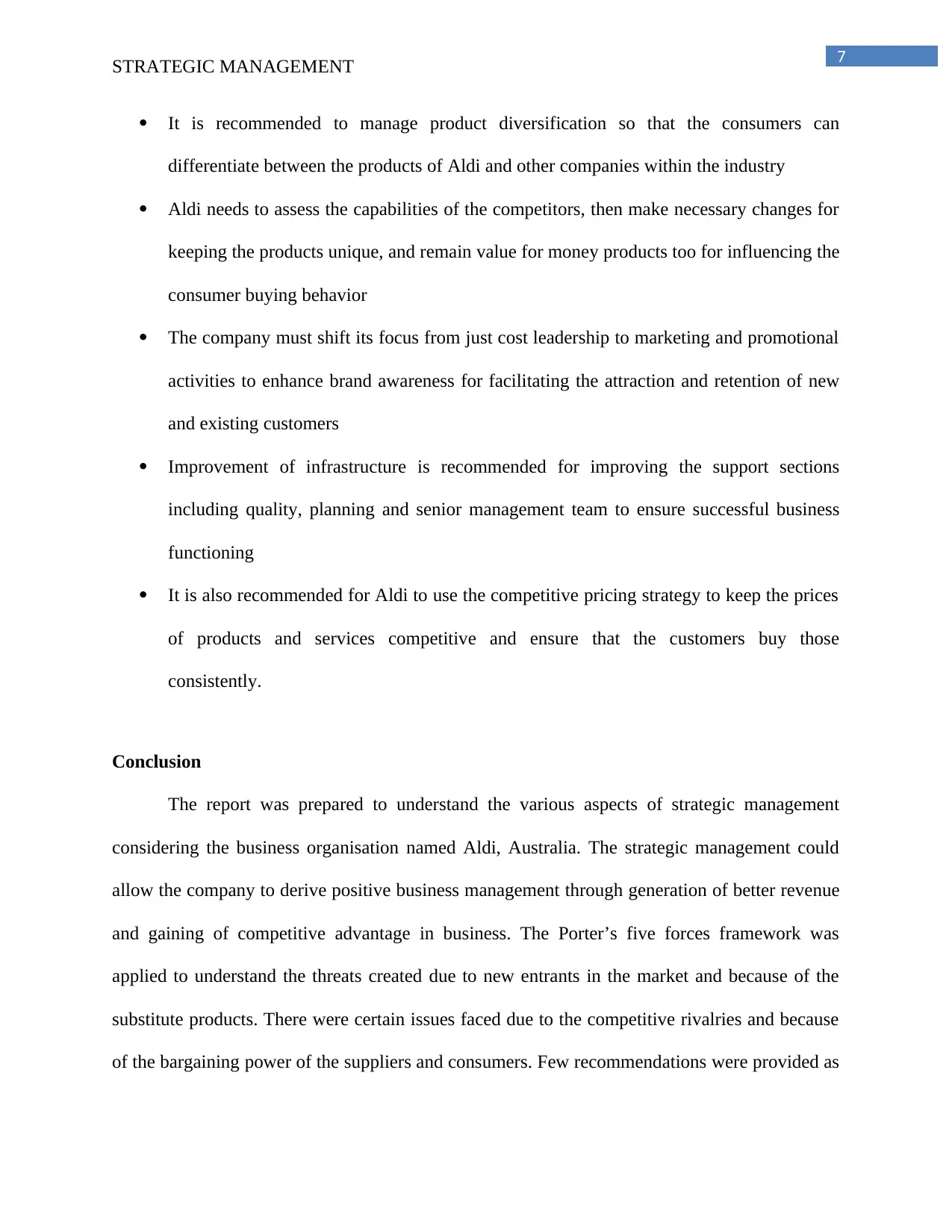
7
STRATEGIC MANAGEMENT
It is recommended to manage product diversification so that the consumers can
differentiate between the products of Aldi and other companies within the industry
Aldi needs to assess the capabilities of the competitors, then make necessary changes for
keeping the products unique, and remain value for money products too for influencing the
consumer buying behavior
The company must shift its focus from just cost leadership to marketing and promotional
activities to enhance brand awareness for facilitating the attraction and retention of new
and existing customers
Improvement of infrastructure is recommended for improving the support sections
including quality, planning and senior management team to ensure successful business
functioning
It is also recommended for Aldi to use the competitive pricing strategy to keep the prices
of products and services competitive and ensure that the customers buy those
consistently.
Conclusion
The report was prepared to understand the various aspects of strategic management
considering the business organisation named Aldi, Australia. The strategic management could
allow the company to derive positive business management through generation of better revenue
and gaining of competitive advantage in business. The Porter’s five forces framework was
applied to understand the threats created due to new entrants in the market and because of the
substitute products. There were certain issues faced due to the competitive rivalries and because
of the bargaining power of the suppliers and consumers. Few recommendations were provided as
STRATEGIC MANAGEMENT
It is recommended to manage product diversification so that the consumers can
differentiate between the products of Aldi and other companies within the industry
Aldi needs to assess the capabilities of the competitors, then make necessary changes for
keeping the products unique, and remain value for money products too for influencing the
consumer buying behavior
The company must shift its focus from just cost leadership to marketing and promotional
activities to enhance brand awareness for facilitating the attraction and retention of new
and existing customers
Improvement of infrastructure is recommended for improving the support sections
including quality, planning and senior management team to ensure successful business
functioning
It is also recommended for Aldi to use the competitive pricing strategy to keep the prices
of products and services competitive and ensure that the customers buy those
consistently.
Conclusion
The report was prepared to understand the various aspects of strategic management
considering the business organisation named Aldi, Australia. The strategic management could
allow the company to derive positive business management through generation of better revenue
and gaining of competitive advantage in business. The Porter’s five forces framework was
applied to understand the threats created due to new entrants in the market and because of the
substitute products. There were certain issues faced due to the competitive rivalries and because
of the bargaining power of the suppliers and consumers. Few recommendations were provided as
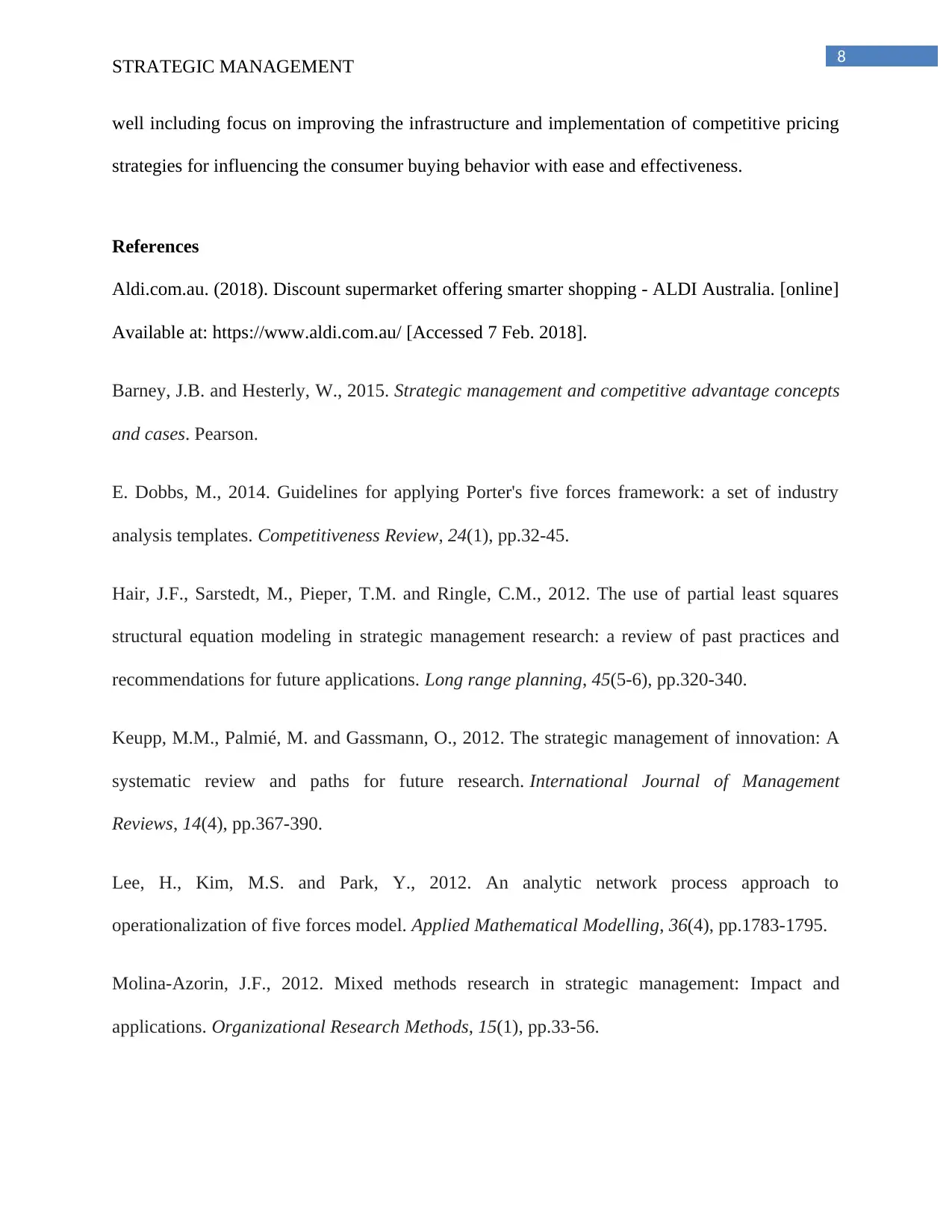
8
STRATEGIC MANAGEMENT
well including focus on improving the infrastructure and implementation of competitive pricing
strategies for influencing the consumer buying behavior with ease and effectiveness.
References
Aldi.com.au. (2018). Discount supermarket offering smarter shopping - ALDI Australia. [online]
Available at: https://www.aldi.com.au/ [Accessed 7 Feb. 2018].
Barney, J.B. and Hesterly, W., 2015. Strategic management and competitive advantage concepts
and cases. Pearson.
E. Dobbs, M., 2014. Guidelines for applying Porter's five forces framework: a set of industry
analysis templates. Competitiveness Review, 24(1), pp.32-45.
Hair, J.F., Sarstedt, M., Pieper, T.M. and Ringle, C.M., 2012. The use of partial least squares
structural equation modeling in strategic management research: a review of past practices and
recommendations for future applications. Long range planning, 45(5-6), pp.320-340.
Keupp, M.M., Palmié, M. and Gassmann, O., 2012. The strategic management of innovation: A
systematic review and paths for future research. International Journal of Management
Reviews, 14(4), pp.367-390.
Lee, H., Kim, M.S. and Park, Y., 2012. An analytic network process approach to
operationalization of five forces model. Applied Mathematical Modelling, 36(4), pp.1783-1795.
Molina-Azorin, J.F., 2012. Mixed methods research in strategic management: Impact and
applications. Organizational Research Methods, 15(1), pp.33-56.
STRATEGIC MANAGEMENT
well including focus on improving the infrastructure and implementation of competitive pricing
strategies for influencing the consumer buying behavior with ease and effectiveness.
References
Aldi.com.au. (2018). Discount supermarket offering smarter shopping - ALDI Australia. [online]
Available at: https://www.aldi.com.au/ [Accessed 7 Feb. 2018].
Barney, J.B. and Hesterly, W., 2015. Strategic management and competitive advantage concepts
and cases. Pearson.
E. Dobbs, M., 2014. Guidelines for applying Porter's five forces framework: a set of industry
analysis templates. Competitiveness Review, 24(1), pp.32-45.
Hair, J.F., Sarstedt, M., Pieper, T.M. and Ringle, C.M., 2012. The use of partial least squares
structural equation modeling in strategic management research: a review of past practices and
recommendations for future applications. Long range planning, 45(5-6), pp.320-340.
Keupp, M.M., Palmié, M. and Gassmann, O., 2012. The strategic management of innovation: A
systematic review and paths for future research. International Journal of Management
Reviews, 14(4), pp.367-390.
Lee, H., Kim, M.S. and Park, Y., 2012. An analytic network process approach to
operationalization of five forces model. Applied Mathematical Modelling, 36(4), pp.1783-1795.
Molina-Azorin, J.F., 2012. Mixed methods research in strategic management: Impact and
applications. Organizational Research Methods, 15(1), pp.33-56.
⊘ This is a preview!⊘
Do you want full access?
Subscribe today to unlock all pages.

Trusted by 1+ million students worldwide
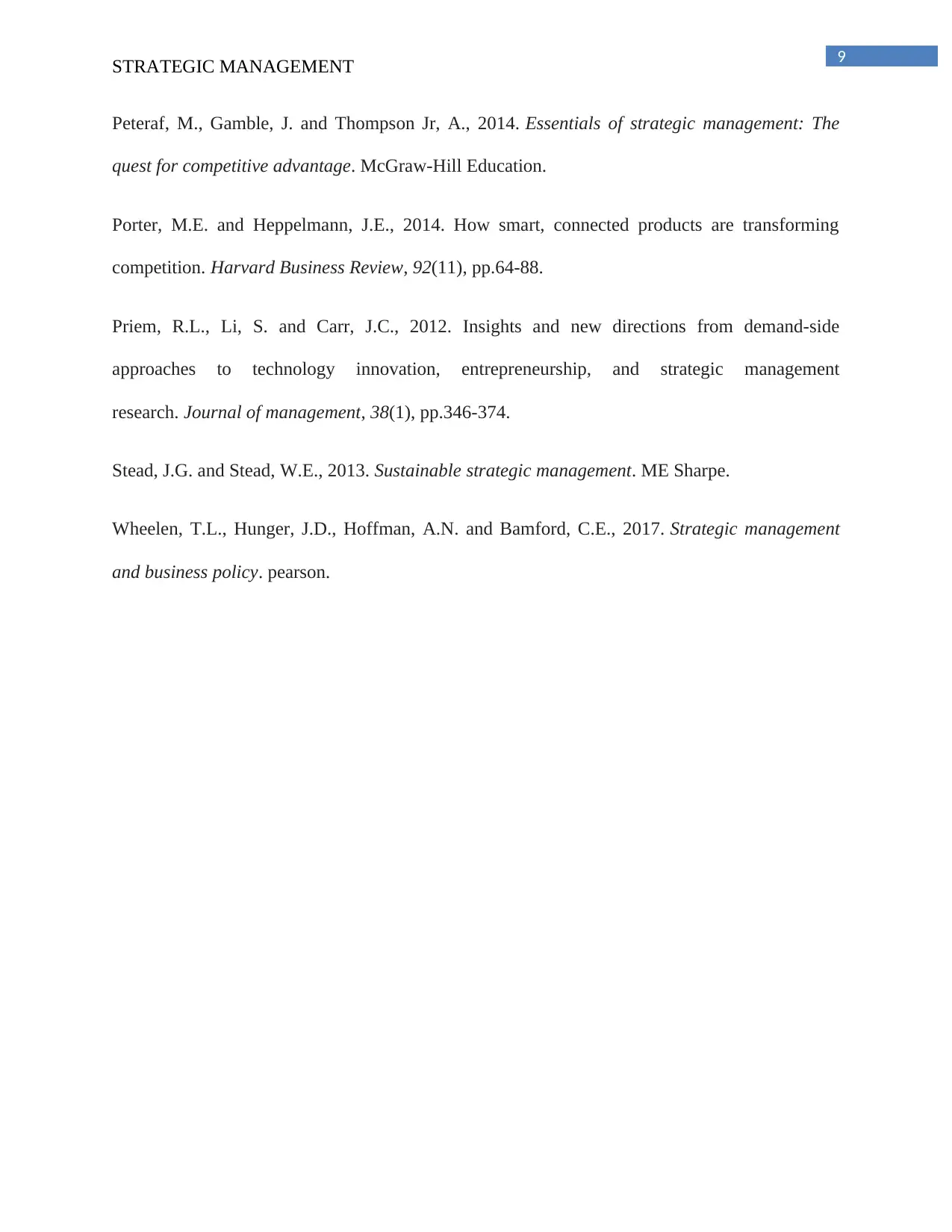
9
STRATEGIC MANAGEMENT
Peteraf, M., Gamble, J. and Thompson Jr, A., 2014. Essentials of strategic management: The
quest for competitive advantage. McGraw-Hill Education.
Porter, M.E. and Heppelmann, J.E., 2014. How smart, connected products are transforming
competition. Harvard Business Review, 92(11), pp.64-88.
Priem, R.L., Li, S. and Carr, J.C., 2012. Insights and new directions from demand-side
approaches to technology innovation, entrepreneurship, and strategic management
research. Journal of management, 38(1), pp.346-374.
Stead, J.G. and Stead, W.E., 2013. Sustainable strategic management. ME Sharpe.
Wheelen, T.L., Hunger, J.D., Hoffman, A.N. and Bamford, C.E., 2017. Strategic management
and business policy. pearson.
STRATEGIC MANAGEMENT
Peteraf, M., Gamble, J. and Thompson Jr, A., 2014. Essentials of strategic management: The
quest for competitive advantage. McGraw-Hill Education.
Porter, M.E. and Heppelmann, J.E., 2014. How smart, connected products are transforming
competition. Harvard Business Review, 92(11), pp.64-88.
Priem, R.L., Li, S. and Carr, J.C., 2012. Insights and new directions from demand-side
approaches to technology innovation, entrepreneurship, and strategic management
research. Journal of management, 38(1), pp.346-374.
Stead, J.G. and Stead, W.E., 2013. Sustainable strategic management. ME Sharpe.
Wheelen, T.L., Hunger, J.D., Hoffman, A.N. and Bamford, C.E., 2017. Strategic management
and business policy. pearson.
1 out of 10
Related Documents
Your All-in-One AI-Powered Toolkit for Academic Success.
+13062052269
info@desklib.com
Available 24*7 on WhatsApp / Email
![[object Object]](/_next/static/media/star-bottom.7253800d.svg)
Unlock your academic potential
Copyright © 2020–2025 A2Z Services. All Rights Reserved. Developed and managed by ZUCOL.




